Estimated reading time 17 minutes, 9 seconds.
Jim Barnes admits that when he arrived in Canada in 2012 to take up business development for Boeing Defense, Space & Security, long-term production of the F/A-18E/F Super Hornet was precarious. By his own estimate, the line that so far has delivered over 600 fighter jets since the mid-1990s appeared ordained to close by 2018 without new customers.
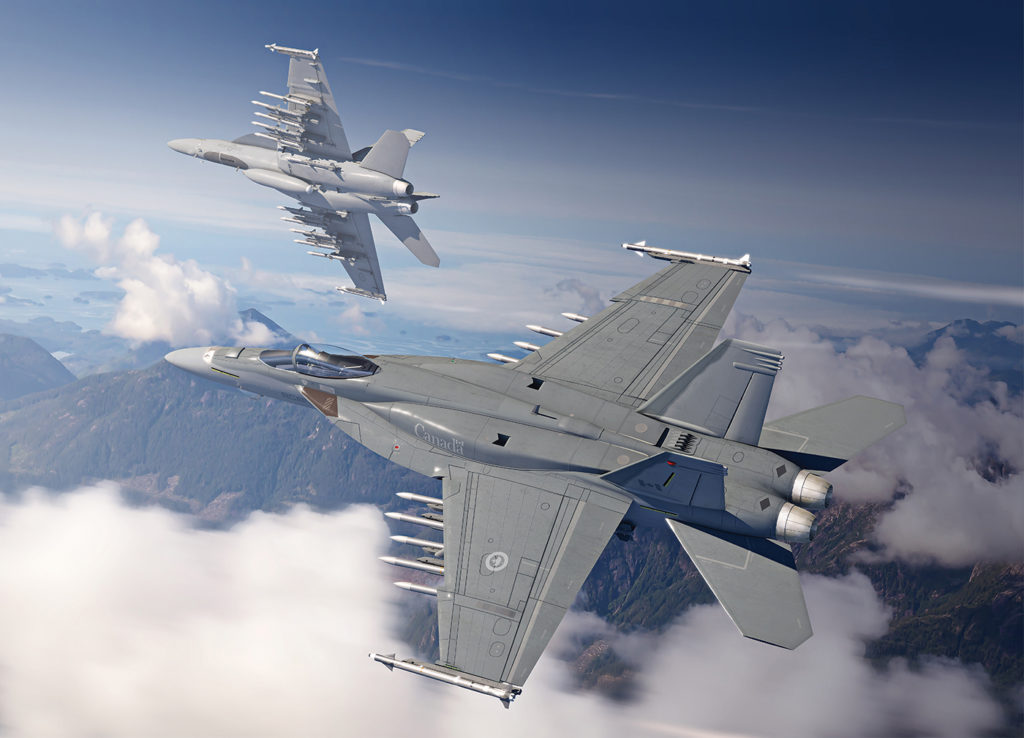
“Now, it is a completely different story because of the U.S. Navy’s commitment to Block III,” he said in a recent interview with Skies. “They need advanced fighters on their carrier decks and the airplane they hoped would be joining that deck isn’t being delivered in a timely manner, so it opened up the opportunity for the Block III.”
Under a multi-year procurement contract, the U.S. Navy will acquire 78 of the advanced aircraft through 2024. Moreover, it has begun a service life modification (SLM) program that will see all or most of its fleet of about 450 Block II Super Hornets upgraded with Block III systems through 2033. The first two were delivered in February.
Boeing will deliver the first Block III testbed aircraft to the U.S. Navy later this spring to begin carrier trials of the computing and networking systems, in advance of the first operational aircraft in early 2021.
“Right now, there is no planned retirement date for the Super Hornet,” noted Barnes, now the director of Fighter Programs in Canada. “It will be a mainstay on carrier decks for decades to come.”
Delays in rolling out Lockheed Martin’s F-35C Lightning II – ‘C’ for carrier variant – undoubtedly spurred renewed interest in the Block III Super Hornet. But the aircraft has also benefited from a collaborative spiral approach to technology development that has ensured new systems are only introduced when they are combat ready. Many of the improved capabilities sought by the Navy for the Block III were first pioneered or trialled on the Block II.
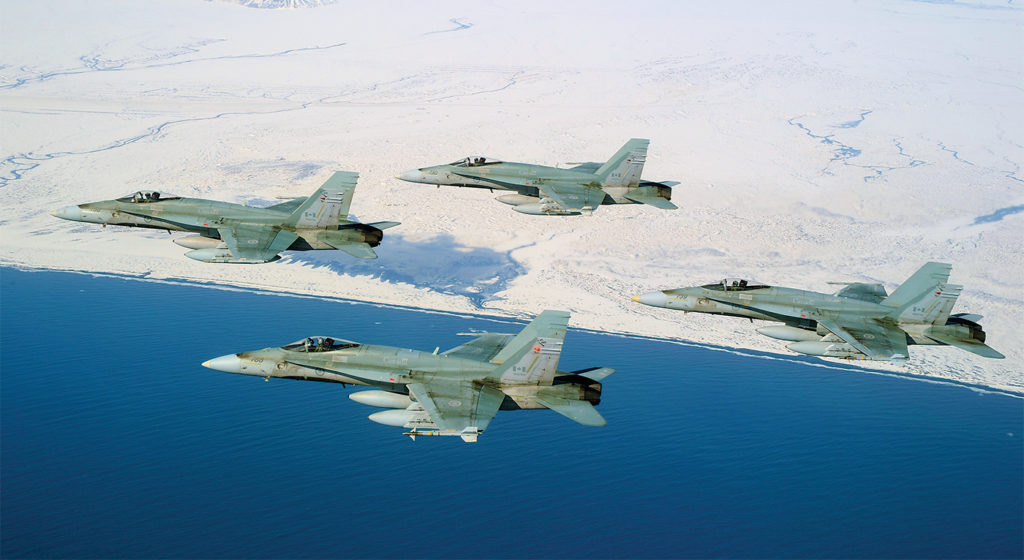
Enhanced capabilities and healthy F/A-18E/F production and SLM lines in St. Louis, Mo., and San Antonio, Texas, are part of a package Boeing hopes will resonate with the Canadian government and Royal Canadian Air Force (RCAF) when they evaluate the contenders to replace Canada’s 30-year-old legacy F/A-18A/B Hornets.
When the request for proposals (RFP) finally closes on June 30 – it was recently extended from March 30 at the “request of industry,” according to the government – Boeing will propose the equivalent of a U.S. Navy Block III aircraft with an instrumented landing system that was previously integrated on Australian and Kuwaiti variants.
The Super Hornet is among three candidates – the others are the Lockheed Martin F-35A Lightning II and Saab Gripen E – vying to replace the Air Force’s remaining 76 CF-188 Hornets. The acquisition and sustainment project, known as the Future Fighter Capability Project (FFCP), for 88 advanced fighter jets is valued between $15 billion and $19 billion. The formal RFP was issued on July 23, 2019, and all three supplier teams (which include the aircraft manufacturer and representative government) had to submit preliminary security offers by Oct. 4, outlining how they intend to meet Canada’s 5 Eyes and 2 Eyes security and interoperability requirements.
“The Super Hornet is a low risk program,” said Barnes. “We only integrate [new] technology when it is ready to reduce risk of schedule and cost, and outpace the threat. And what comes with that next-generation capability is predictable and affordable costs, not only for acquisition, but also for the [operational] lifecycle.”

Cost and capability
Comparing aircraft costs is always problematic. The process by which a fighter is acquired can significantly affect the final price, and Canada would buy the Super Hornet under a government-to-government foreign military sale, which can inflate the cost by as much as 30 per cent. But a multi-year procurement for the Block III in the U.S. president’s budget for fiscal 2020 projected a cost of about US$66 million per aircraft, and estimates in the past two years have suggested a price of US$70 million.
“The cost for Canada will depend on how many aircraft they buy and when they are taking delivery, but that’s a great place to start,” said Barnes.
The more important figure for Boeing, though, is the operating cost. The current cost per flight hour for the Super Hornet is around US$18,000, well below the F-35A, which Lockheed Martin officials recently told Skies is above US$30,000 and striving to reach US$25,000 by 2025.
“If you do the math on 88 airplanes flying for 30 years at about 250 hours per year, that is billions of dollars in savings over the life of that platform,” noted Barnes.
The Block III program will also extend the Super Hornet to a 10,000-flight-hour airframe for Navy operations. Given that the RCAF, through life extension programs, has managed to push the CF-188 well beyond its intended 6,000 flight hours, that increased airframe life bodes well for an air force that doesn’t operate in a highly corrosive saltwater environment, slam its jets down on short carrier decks or take off from catapults, noted Ricardo Traven, Boeing’s former F/A-18 Super Hornet chief test pilot and currently the lead test pilot for the 787 Dreamliner. “It is 10,000 [airframe hours] for the Navy; I really don’t know what it could be for an air force. It is one strong airframe.”
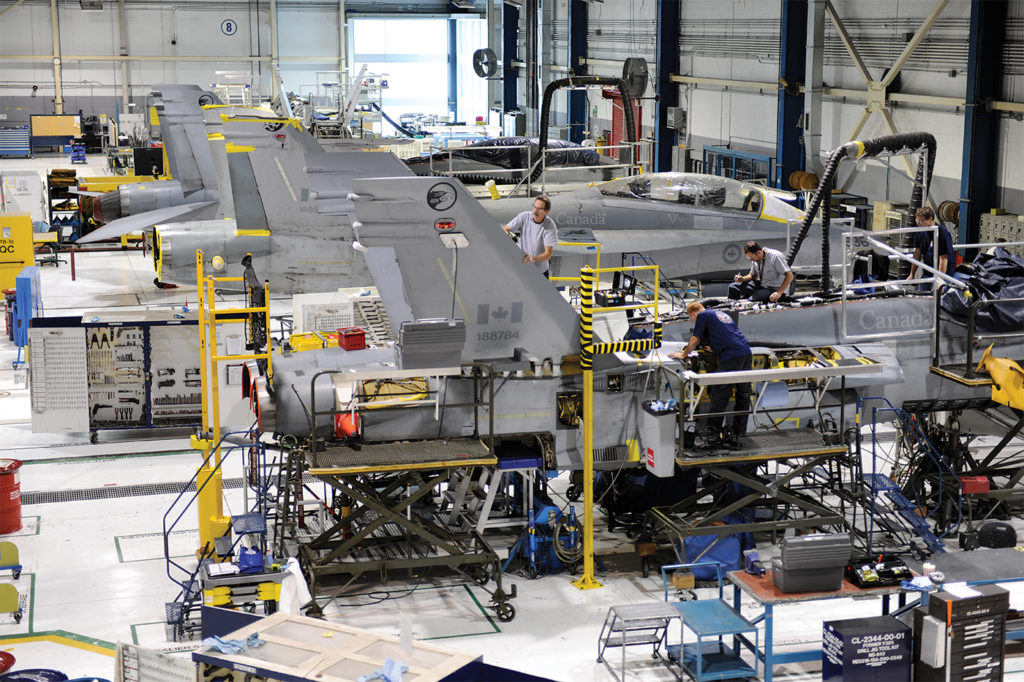
The Block III configuration introduces significant upgrades, including conformal fuel tanks (CFT), enhanced coatings to reduce radar signature, advanced mission computers and data links, and a single, customizable wide-area multi-function display. It also includes improvements originally planned for the Block II such as a centreline drop tank with a networked infrared search and track (IRST) sensor and satellite communications (SATCOM) system.
Many of these will be critical to meeting the RCAF’s stated mission requirements, but Boeing is hoping to gain some credit for capabilities that are not specifically part of the RFP.
Side-by-side, the Super Hornet boasts a much larger airframe compared to the legacy Hornet. But that added wing span and extra flex means more fuel, weapons and electronics, and greater manoeuvrability than smaller competitors, said Traven, a former major in the RCAF from southern Ontario.
“You have a bigger airplane that is more manoeuvrable, and can fly slower than the legacy fighter on approach because of those big areas, which is important when coming into land on a short, snowy or wet runway in forward operation locations like Inuvik,” he said. “You don’t have to flare at all, you can plant the airplane on the first few metres of runway on touchdown. And the landing gear is very rugged. The Super Hornet has two nose gear tires – most others have one – and that counts on wet runways and snow.”
The conformal fuel tanks expand the Super Hornet’s standard combat air patrol mission range by about 20 per cent or increase the loiter time by roughly 30 minutes, said Barnes. A clean Super Hornet carries 14,000 pounds of fuel, the same as a legacy Hornet with two extra fuel tanks, noted Traven. “Take away the drag of the pylon and tanks and you can see that the Super Hornet will go significantly farther on a clean airplane.”
At a time when the RCAF has limited strategic tanking and is poised to retire the tactical air-to-air refueling provided by the CC-130H Hercules, the Super Hornet offers a unique feature: It can serve as its own tanker. If tanking isn’t readily available, the possibility of adding a fifth jet to support a four-ship of fighters responding to a NORAD quick reaction alert mission could be “a game changer,” noted Traven.

As part of spiral technology development, the Block III replaces the previous two mission computers with a Distributed Targeting Processor-Networked (DTP-N), an onboard system that when combined with the Navy’s future Targeting Tactical Network Technology (TTNT) will allow data sharing at speeds and volume that greatly exceed current Link 16 tactical data exchange capabilities.
Multiple Block III Super Hornets with DTP-N and the longwave IRST sensor integrated into the centreline nose tank “can solve targeting and the distance equation, which was almost impossible with a single ISRT,” said Traven of what he called an anti-stealth capability. “You can target stealth airplanes at very long range without the radar because you can process its location. First, you can locate it based on the heat signature, and you can process the distance and speed and tracking by having multiple sources talking to each other through this distributed processing targeting network. With the upgraded DTP-N, combined with TTNT, it is checkmate for the whole fifth-gen argument. The amount of information we can share is unbelievable.”
He emphasized that the U.S. military, not aircraft manufacturers, would establish the data protocols by which fighters communicate information and would not permit a closed network dictated by one type of aircraft.
Boeing has long disputed the stealth argument, maintaining the Super Hornet incorporates enough stealthy technology, including enhancements to the Block III, to perform the broad range of missions. Traven said the Navy has taken a pragmatic approach, asking for as much stealth as possible without sacrificing the capabilities that are important to its mission sets.
“That advanced processor, DTP-N, and the advanced data link, TTNT, and the advanced communication, the SATCOM, were all proven on the EA-18G Growler. That is the Super Hornet way of low-risk integration of advanced capabilities,” added Barnes.
Though the debate about one versus two engines has faded in recent years, Traven remains a believer in the twin engine. Based on RCAF experience flying the NORAD mission deep into the Arctic and conducted missions across the North Atlantic, he said that distance and the unexpected remain factors that can trump reliability. While he doesn’t dispute the dependability of next-generation single engines, even the best can’t account for a wayward Canada goose.
“I need two engines because of all the unknowns, especially on approach to Inuvik when you see a [Canada] goose go by that can take out your engine, or the chunk of ice that goes down the intake on takeoff, or the hydraulic line that wasn’t tightened exactly right. All of those things are never included in the engine reliability argument.”
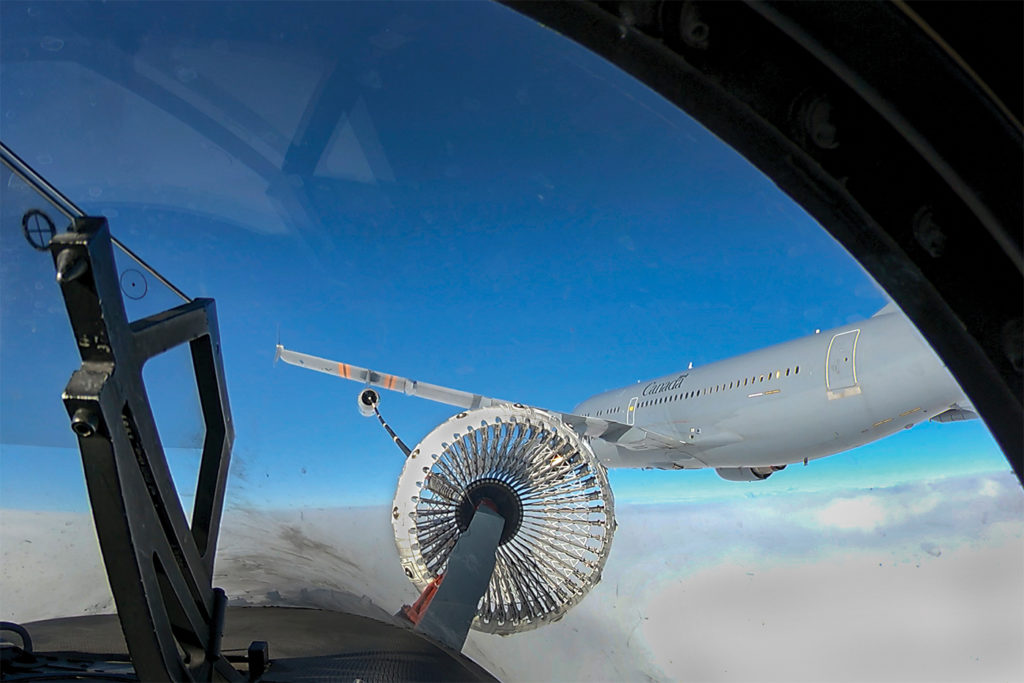
Mission systems and aircraft performance will be paramount in any Air Force evaluation, but the ease of transition from the CF-188 to the Super Hornet may also earn Boeing points. In interviews with Skies at the U.S. Navy’s Fleet Replacement Squadron and at the Center for Naval Aviation Technical Training Unit, both in Norfolk, Va., pilots and maintenance technicians described conversion programs from the F/A-18C to the E of about three months for pilots and four to six months for techs, depending on the systems.
“A lot of that training transfers one for one,” observed Traven, noting the similarity of most systems in the cockpit and throughout the aircraft.
Just as important, all the ground support equipment (GSE) and tooling is the same, meaning equipment at operating squadrons and forward bases would not need to be replaced. Both Traven and Barnes observed that while there was mention of infrastructure in the RFP, there was no discussion of the support systems and even runway lengths that might have to change with other aircraft. “I think that has been lost in this whole discussion,” said Traven.
“It is a big deal and I hope they are considering that in an appropriate manner,” added Barnes. “When you are already operating legacy Hornets, the requirement to get current maintainers and pilots up to speed on a Super Hornet is much less than it would be starting from scratch.”
Value proposition
As part of its bid, Boeing has reactivated the team that successfully delivered the CF-188 Hornet in the 1980s, including L3 Harris MAS, Peraton, CAE, Raytheon Canada and GE Canada.
“What we are trying to do is leverage the billions of dollars of investment the government has already made in the fighter support infrastructure and utilize that on the Super Hornet,” said Barnes.
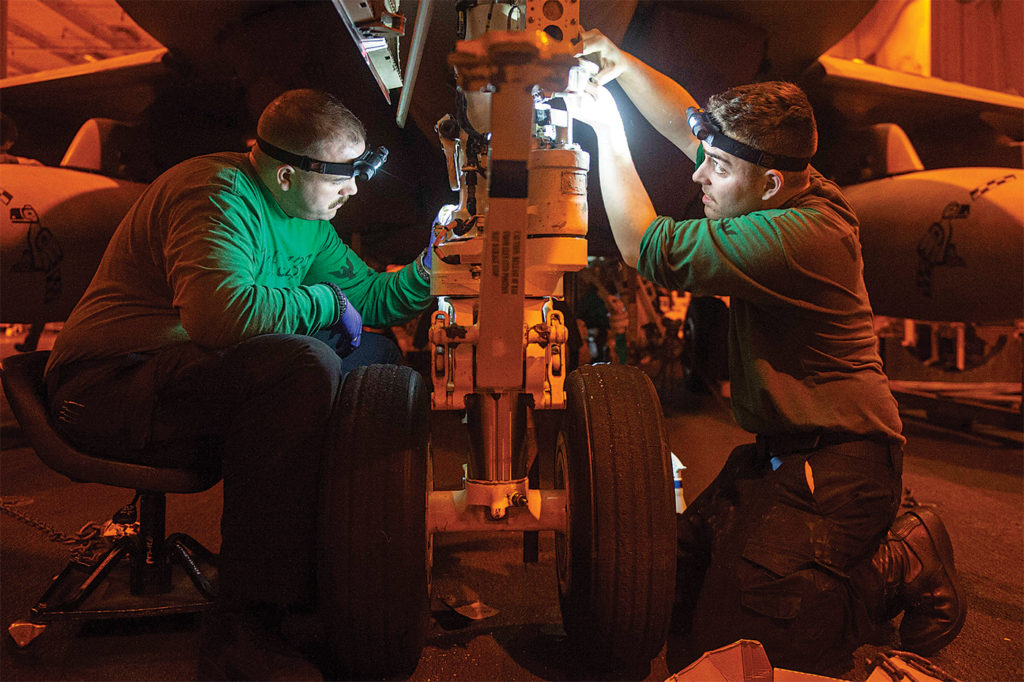
Over the years after the CF-188 was acquired, companies like L3 Harris MAS in Mirabel, Que., developed detailed knowledge about every airframe in the fleet. Boeing is not proposing a wholesale transfer of Block III intellectual property (IP), but rather a gradual handover. “As Canada got more familiar with the [legacy Hornet] platform, more intellectual property was exchanged,” said Barnes. “Our plan would be to do that same approach on the Super Hornet. We’ll do as much as we can on day one, but it will probably be an evolution over time. The Canadian companies certainly understand that.”
Mission system technologies would have to be part of a government-to-government negotiation, he added, but would likely be part of an incremental transfer over time.
The IP discussion is part of Boeing’s proposal to meet Industrial and Technological Benefits (ITB) obligations. The three bidders will have the option to sign a binding ITB agreement and commit to investing in Canadian content up to 100 per cent of the contract value, or agree to a nonbinding economic benefit agreement.
“We will sign the binding agreement,” said Roger Schallom, senior manager for International Strategic Partnerships.
As part of its value proposition, Boeing will also meet the specific requirements around investment in small- and medium-sized businesses, innovation, skill development and long-term sustainment. Fulfilling a 100 per cent Canadian content value obligation often means spending far more than the actual contract value, said Schallom. On a program valued over $15 billion, manufacturing work packages could translate into as much as $30 billion in actual work for Canadian companies over the 25 years Boeing would have to fulfil its ITB commitment.
For example, Boeing’s ITB obligation for the CH-147F Chinook helicopter program was about $1.3 billion. “We are going to spend in purchase orders about $2.6 billion of work in Canada,” he added.

More important to companies that have supported the CF-188 would be the 30-plus years of guaranteed in-service support (ISS) contracts. “Those are the billions of dollars that could be left on the table if you go with the nonbinding solution,” emphasized Barnes.
“You have to give your ISS companies credit for getting specific sustainment percentages in the RFP,” added Schallom. “They are wielding a pretty big hammer right now. If you go nonbinding, [that economic return] is a big question mark.”
It could be argued Boeing Defense, Space & Security missed an opportunity to claim an edge in the FFCP when, in 2017, the Canadian government withdrew the planned purchase of 18 Super Hornets. The aircraft were being considered to fill an interim capability gap in the RCAF’s ability to simultaneously conduct NORAD and NATO missions, but the purchase was cancelled over a trade dispute between Boeing Commercial and Bombardier’s
C Series airliner program.
But, with the Canadian fighter competition about to finally close, Boeing clearly believes it’s well positioned with an advanced fighter jet that can meet all mission requirements well into the future, while returning significant economic benefits to Canadian industry for a predictable and affordable cost.
It’s an offer Canada will have to weigh carefully.
Chris Thatcher is an aerospace, defence and technology writer, editor of RCAF Today, and a regular contributor to Skies.


In spite of the fact that the F-35A is the world only fifth generation fighter with the F-22A Raptor, I wish Canada will pick the Boeing F-18E/F Hornet. By the same token Canada should replace its Airbus CC-150 Polaris with Boeing KC-46A Pegasus and its Lockheed CP-140 Aurora (P-3A Orion) with Boeing P-8A Poseidon.
My problem with the F-35A is the fact that Lockheed Martin, an American Icon, signed a deal with the heavily subsidized French-German- Spanish Airbus to market the European tanker A330MRRT in North America.
Nevertheless, I fear that Canada will pick any way the Airbus tanker under the restless and heavy lobbying from the team of Airbus military in Ottawa and the one of Airbus commercial in Mirabel. Moreover, Airbus will give the maintenance of the A330MRTT to Air Transat in Montréal, an all Airbus fleet airline already operating A330.
Not sure why Airbus should be disqualified because of its subsidies. Virtually all major aerospace companies have some degree of government support including Boeing which has access to low cost federal loans. The Airbus tanker has won a number of recent competitions and I’ve even heard US Air Force personnel speak highly of the Airbus tanker.
Philippe , I don’t know if I’d call the F-35 a “5th-gen” aircraft because the original definition of the term “5th-gen”, as was posited by Lockheed-Martin when they introduced the F-22 included supercruise capability. Supercruise capability became something that Lockheed conveniently (and dishonestly) forgot when they released the F-35A. The term “5th-gen” is meaningless anyway because Lockheed-Martin tried to TRADEMARK the term! Ignore the “generation” of a plane and look instead at its capabilities if you really want to understand military aviation. I’ve been a military aviation enthusiast for over 30 years and this “generation” idea is just a lazy way for laypeople to have some idea about a topic that is normally far too complex for them to wrap their heads around. Lockheed WANTS laypeople like you to have the term “5th-gen” in your head because it means that their marketing is working. No knowledgeable military aviation enthusiast takes the “5th-gen” moniker seriously.
I understand your aversion to corporations that receive government hand-outs but EVERY aerospace corporation gets them. Boeing gets more subsidies in the USA than either Lockheed-Martin or Northrop-Grumman. The difference is that the US government gives subsidies in the form of tax breaks instead of giving them money. The net result is the same, millions of dollars in Boeing’s coffers instead of the government’s. Don’t be fooled by Boeing’s dishonest stance, they are a HEAVILY subsidised corporation.
I think that the F18 block 111 is an excellent platform for RCAF as we certainly have had durability,reliability, near thirty years with F18 first models. The plane operational cost much lower than some of other contenders, two engines for safer northern operational requirements. Airframe very durable,landing gear heavy duty for rough & possible snow ice conditions. The main reason for procurement is this plane has proven itself over many years & Canadian industry have extensive knowledge on this platform. This plane will integrate well with our USA partner in many operations as in NATO. Thank You
The F/A-18E’s operational cost is lower than “some of the other contenders”? There are only two other contenders and the Rhino is only cheaper than one of them, the F-35A (and that’s not setting the bar very high) so your statement makes no sense. As for the “two engines are safer” myth, the JAS-39 Gripen has been THE SAFEST FIGHTER JET IN HISTORY despite having only one engine. From its first flight in 1988 to today, none of the 272 Gripens produced have ever suffered an engine failure. These aircraft are in service with Sweden, Thailand, South Africa, Hungary and Czechia. One is even used for fast jet training at the Empire Test Pilots’ School in the UK.
If you want to talk safety, based on the service records of the JAS-39 and CF-18 over the past 25 years that the Gripen has been in service, if you were a pilot, you were TWENTY TIMES more likely to die in a CF-18 than a JAS-39 (I’ve done the math). The only death of a Gripen operator tragically occurred at the Thai Children’s Day Air Show in January of 2017. However, after a full investigation by the Royal Thai Air Force, they found that the plane did not cause the crash. No fighter jet has shown itself to be the equal of the Gripen when it comes to safety and reliability so that “two engines are safer” myth can go right out the window where it belongs.
After what Boeing did to Bombardier, I don’t even want to see their passenger planes here. If you cared about Canada, you’d feel the same way.
This is a very good article and proposal I have been a fan of the F18 since day one and have followed the rise of the original Hornets .I have watched with interest the Super Hornet and the countries purchasing them . I believe the transition from the older Hornets to the Super Hornet may be a lot easier than transitioning into a F35 I believe the Block 3 is a good looking aircraft and has some Major upgrades /Canada has always been a support military and I can see the Super Hornet would be more in Canada’s interest and would be a great plane .The F35 is a great plane but for Canada’s need in NORAD and Nato the F18 would be better .
You do realise that there are THREE aircraft in the running, eh? I’m guessing that you’re American because I don’t think a Canadian would pretend that the Gripen didn’t exist. It doesn’t matter because with the Liberals having only a minority government they can’t just choose whatever they want. The NDP and BQ will both only support the Gripen so Trudeau’s hands are tied. The age of the Hornet in Canada has come to an end.
Caveat Emptor – The words “Boeing says” are all that you need to know to understand that the information will not be from an unbiased source. It’s not like Boeing would say that the Rhino ISN’T good for Canada because they’re salespeople. No mention is given of the badly designed wings resulting in the canted missile pylons that dramatically increase drag. This happened because Boeing wasn’t interested in accepting the costs of fixing their own design mistake.
Boeing, I’m actually kinda glad that you did what you did to Bombardier Aerospace because your greed caused you to snatch defeat from the jaws of victory. The Liberals were willing to use the average Canadian’s ignorance in their favour by selecting the “Super” version of our CF-18 instead of that horrible F-35A and you managed to screw that up ROYALLY! The more that people actually read about the three planes involved, the more we see that your F/A-18E is not even close to being a match for the JAS-39E when it comes to Canada’s needs. The RCAF’s primary mission is defensive counter-air, not anti-ship and coastal assault operations. Your plane works great for an island nation like Australia because they’re too remote to really be threatened by aircraft directly. Australia can only be threatened by naval assets and in that way, Australia is like one big aircraft carrier. Canada’s northern proximity to Russia is a completely different story as Russian planes can (and do) reach Canada without a carrier.
I’ll take the plane from the country that is only one Finland away from Russia’s Kola Peninsula, a major Russian military complex because they know what it’s like to be directly threatened. The F/A-18E is so well-optimised for carrier (or island) defence operations that it has sacrificed it’s A2A capability, a capability that the Gripen has in spades, a capability that is paramount to the defence of Canada’s airspace.
Two engines are mandatory in Canada. The F35…too expansive and one engine only. The Saab …one engine only. So why not the F16…more for the bock? Or why not the F15…expensive with two engines but what a plane. At the end tough choice. One big problem. Our dear government is always slow on all big decisions.
Two engines USED to be mandatory in Canada. Just like MORE than two engines USED to be mandatory for trans-oceanic commercial jetliners. Not anymore though. The Gripen has the best safety record in fighter jet history. In 25+ years of operation with 5 air forces being based in every climate zone on Earth, no Gripen has EVER suffered an engine failure. That’s right, NEVER. The Gripen has been safer and more reliable than every single or twin-engined fighter jet ever made. In fact, it has a better absolute safety record than most commercial jetliners becuase it has never crashed due to a technical problem with the plane itself. Look it up if you want to. While you’re at it, you can also verify that only one pilot has ever died in a Gripen, a squadron leader in the Royal Thai Air Force. The RTAF did a thorough investigation into the crash (which was caught on film because it was at the Children’s Day Air Show) and their findings were that the plane itself did not cause the crash. They also subsequently asked Saab about getting even more Gripens, not something that an unsatisfied customer would do.
The Czech routinely flew their Gripens to Iceland to patrol their skies as part of a NATO operation. That’s a VERY long flight over the icy waters of the North Atlantic and all the flights went off without a hitch. The Czechs are now interested in the Gripen-E because of their amazing experieces with the Gripen-C.
So much fot the “mandatory” two engines theory, eh? If I’m a pilot, I want the plane with the spotless safety record, the number of engines be damned.
Well, the Canadian government saw through all of the BS that was presented here by those two completely biased contributors.
The “Super” Hornet got bounced so they can “Boeing, Boeing, Boeing!” their way outta here!
The JAS-39E has officially defeated the F/A-18E for the SECOND time!
I don’t believe that there’s a chance in hell that we’re insane enough to take the F-35 so that means GRIPENS FOR CANADA BABAY!!! 😀